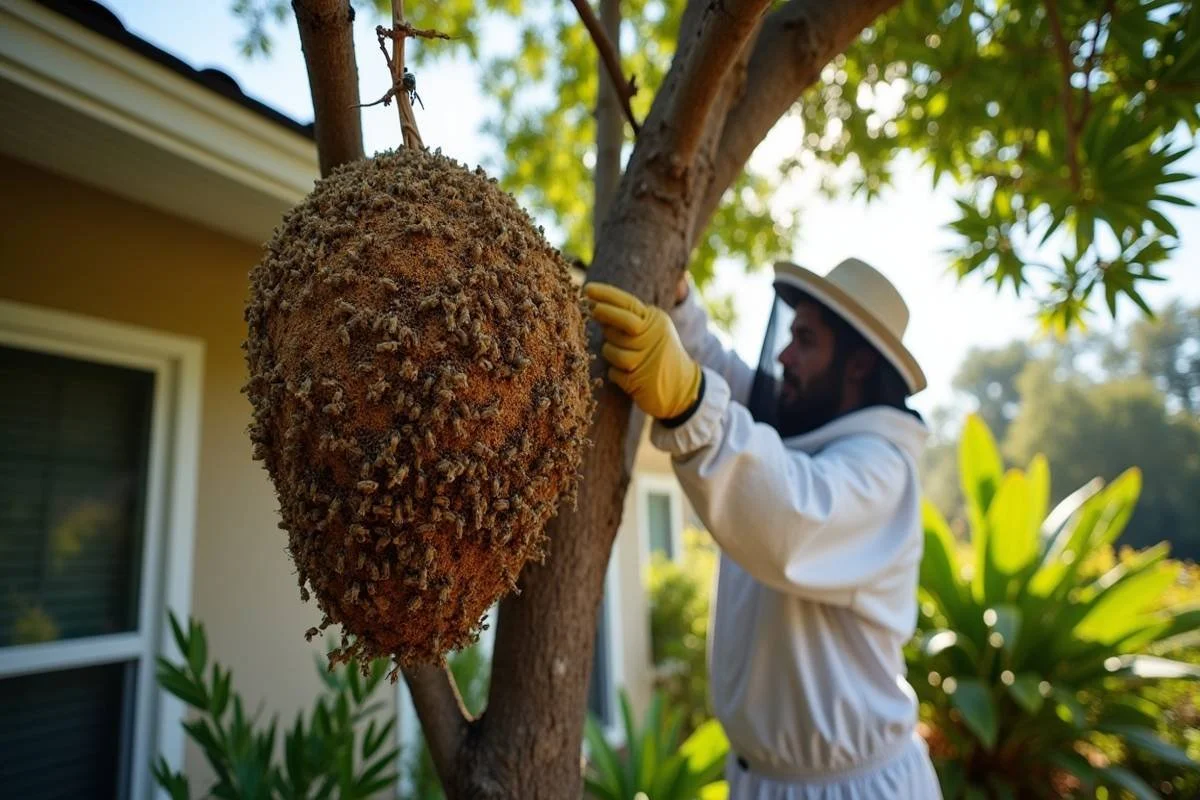🐝 Why Bees Choose Florida Homes Over Trees: The Surprising Truth.
When most people picture bees building a hive, they imagine a peaceful swarm hanging from a tree branch. But here in Florida, more and more bees are nesting in attics, wall voids, and even water meter boxes.
Why are bees in Florida choosing homes instead of trees? The truth may surprise you. From environmental changes to smart bee behavior, this blog explores why Florida homes have become prime real estate for bees—and what homeowners can do to protect their property while protecting the bees.
🌴 Florida’s Changing Landscape Is Forcing Bees to Adapt
Florida is rich in biodiversity, but it’s also one of the fastest-growing states in the U.S. With rapid development, many natural bee habitats are being lost.
Here's why bees in Florida are turning to homes:
"Live bee removal from Florida home tree."
Urban sprawl: Forests and open fields are cleared for homes and roads, removing old-growth trees where bees normally nest.
Climate extremes: Florida’s intense heat, rain, and humidity make traditional tree hives riskier for survival.
Fewer wildflower areas: Landscaping choices often reduce the native plants that bees rely on for food.
Limited tree hollows: Bees prefer cavities to build hives, and these are harder to find in suburban neighborhoods.
With fewer options in the wild, bees are adapting to human environments—and Florida homes provide the perfect shelter.
🏠 Why Bees Prefer Florida Homes Over Trees
Florida homes unintentionally offer ideal hive conditions. Here’s why local homes attract bees:
1. Warm, Stable Environments
Florida attics and wall cavities offer consistent warmth and protection from storms and humidity—ideal for brood and honey production.
2. Easy Entry Points
Soffits, vents, roof gaps, and cracks in siding allow bees easy access. In Florida’s older or storm-damaged homes, these openings are common.
3. Abundant Landscaping
Florida yards are full of hibiscus, citrus blossoms, palm flowers, and tropical plants—great nectar sources for bees.
4. Quiet, Undisturbed Spaces
Bees love quiet areas like wall voids and attics. Once inside, they may build a hive for months before anyone notices.
5. Year-Round Activity
Florida’s mild winters mean bees can stay active longer, making homes even more attractive compared to seasonal tree hollows.
🐝 Common Signs of a Bee Hive in Your Florida Home
Bee infestations are often discovered late in Florida homes due to subtle signs. Look for:
Buzzing inside walls, ceilings, or near vents
Bees entering and exiting a single point in the siding or roof
Sticky stains or dark patches on walls (leaking honey)
Unusual sweet smells inside the home
A rise in bee activity around your yard or soffit
If you notice these signs, call a Florida-based bee removal expert immediately.
🚫 Don’t Kill the Bees – Relocate Them Safely
In Florida, bees are critical to agriculture and the environment. Extermination harms pollinator populations and often causes more problems:
Rotting honeycomb can leak into walls, attract ants or roaches, and cause structural damage
Pesticides may linger and affect your family or pets
Queen bees often survive chemical sprays, and the colony can rebuild itself
Environmental harm: Bees pollinate over 100 fruit and vegetable crops in Florida
Instead, choose live bee relocation in Florida—a humane, eco-conscious method that protects your home and our state’s ecology.
✅ Our Eco-Friendly Bee Removal Process in Florida
At Eco Bee Removal, we proudly serve homeowners across Florida with humane, chemical-free solutions. Our bee removal process includes:
Local Inspection – We assess the bee activity and identify hive locations specific to your Florida property layout.
Safe Live Removal – We use smoke-free, non-toxic tools to gently remove the bees.
Hive Cleanup – All honeycomb and wax are removed to prevent future infestations or damage.
Relocation to Florida Apiaries – We safely rehome the bees to managed hives or conservation areas across Florida.
Bee-Proofing – We seal entry points and advise you on how to prevent future hives.
🛡️ How Florida Homeowners Can Bee-Proof Their Property
Prevention is key—especially in Florida, where swarming season is long. Here’s how to protect your home:
"Storm-damaged Florida home with fallen tree"
Seal gaps in soffits, vents, siding, and chimneys
Install fine mesh screens on attic vents and roofline openings
Trim overhanging trees and plants near the roof or walls
Repair storm or hurricane damage quickly—damaged homes are common hive targets
Schedule seasonal inspections before and after Florida’s spring swarming season
📍 Serving Florida Bee Removal Needs Statewide
We proudly serve all major regions of Florida, including:
South Florida: Miami, Fort Lauderdale, West Palm Beach
Central Florida: Orlando, Kissimmee, Lakeland
West Coast Florida: Tampa, Sarasota, Fort Myers, Cape Coral
North Florida: Jacksonville, Gainesville, Ocala
Wherever you are in Florida, our team of trained professionals is ready to remove and relocate bees safely and responsibly.
📞 Call Now: (888) 282-1886
🌐 Visit: https://www.ecobeeremoval.com
❓ Florida Bee Removal FAQ
Q1: Are bees in my Florida attic dangerous?
While honey bees are not aggressive, disturbing a hive in your attic can lead to stings. Professional removal is safest.
Q2: What time of year are bees most active in Florida?
Spring and summer are peak swarming seasons, but in Florida’s warm climate, bees can remain active into fall.
Q3: How long does a bee removal job take?
Most removals are completed in 2–4 hours, depending on hive size and location.
Q4: Will the bees come back?
Not if the hive is fully removed and the entry points are sealed. We provide complete bee-proofing solutions.
Q5: Do you relocate bees locally in Florida?
Yes! We relocate all live bees to registered Florida apiaries or conservation zones to protect pollinator health.
🌎 Final Thoughts for Florida Homeowners
The trend of bees choosing homes over trees is especially visible here in Florida. With disappearing natural habitats and year-round warmth, our homes have become new nesting grounds.
But killing bees is not the answer. Eco-friendly bee removal and relocation protect both your home and Florida’s fragile pollinator population. If you hear buzzing in your walls or spot bees near your attic, don’t wait—call a local expert.
🐝 Serving All of Florida — Safe, Fast, and Eco-Friendly


